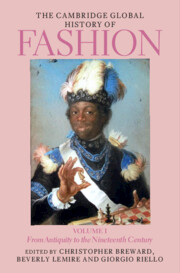Book contents
- The Cambridge Global History of Fashion
- The Cambridge Global History of Fashion
- The Cambridge Global History of Fashion
- Copyright page
- Contents for Volume I
- Figures for Volume I
- Maps for Volume I
- Table for Volume I
- Contributors for Volume I
- Preface
- 1 Global History in the History of Fashion
- Part I Multiple Origins of Fashion
- Part II Early Modern Global Entanglements
- Part III Many Worlds of Fashion
- 13 ‘Black Cloth’
- 14 Fashion and Moral Concern in Early Modern Japan
- 15 Textiles and Fashion in Southeast Asia
- 16 Fashion in Ming and Qing China
- 17 Everyday Fashion in the Ottoman Empire,C. 1600–1800
- 18 Imperialism and Fashion: South Asia, c. 1500–1800
- 19 Fashion Systems in the Indian Ocean World, from Ancient Times to c. 1850
- 20 Fashion and First Peoples in European Settler Societies, c. 1700–1850
- Index
- References
14 - Fashion and Moral Concern in Early Modern Japan
from Part III - Many Worlds of Fashion
Published online by Cambridge University Press: 04 August 2023
- The Cambridge Global History of Fashion
- The Cambridge Global History of Fashion
- The Cambridge Global History of Fashion
- Copyright page
- Contents for Volume I
- Figures for Volume I
- Maps for Volume I
- Table for Volume I
- Contributors for Volume I
- Preface
- 1 Global History in the History of Fashion
- Part I Multiple Origins of Fashion
- Part II Early Modern Global Entanglements
- Part III Many Worlds of Fashion
- 13 ‘Black Cloth’
- 14 Fashion and Moral Concern in Early Modern Japan
- 15 Textiles and Fashion in Southeast Asia
- 16 Fashion in Ming and Qing China
- 17 Everyday Fashion in the Ottoman Empire,C. 1600–1800
- 18 Imperialism and Fashion: South Asia, c. 1500–1800
- 19 Fashion Systems in the Indian Ocean World, from Ancient Times to c. 1850
- 20 Fashion and First Peoples in European Settler Societies, c. 1700–1850
- Index
- References
Summary
In the 1580s Japan began to extricate itself from a barely imaginable 100-year civil war. Fighting had not been continuous, nor everywhere, but bloodshed had been prevalent enough to form what has been called a ‘culture of civil war’.1 The capital, Kyoto (kyōto means ‘capital’) was reduced to ruins. Its historic grid had been wiped away. The sovereign, ancestor of today’s emperor of Japan, had long since ceased to enjoy his ancient titles, and was known metonymically merely as ‘the palace’, though in truth, he was as likely to be lodging in a warlord’s mansion. People at the time defined their world as gekokujō, ‘those below overthrowing those above’ – the literal meaning of revolution.
- Type
- Chapter
- Information
- The Cambridge Global History of FashionFrom Antiquity to the Nineteenth Century, pp. 472 - 499Publisher: Cambridge University PressPrint publication year: 2023



